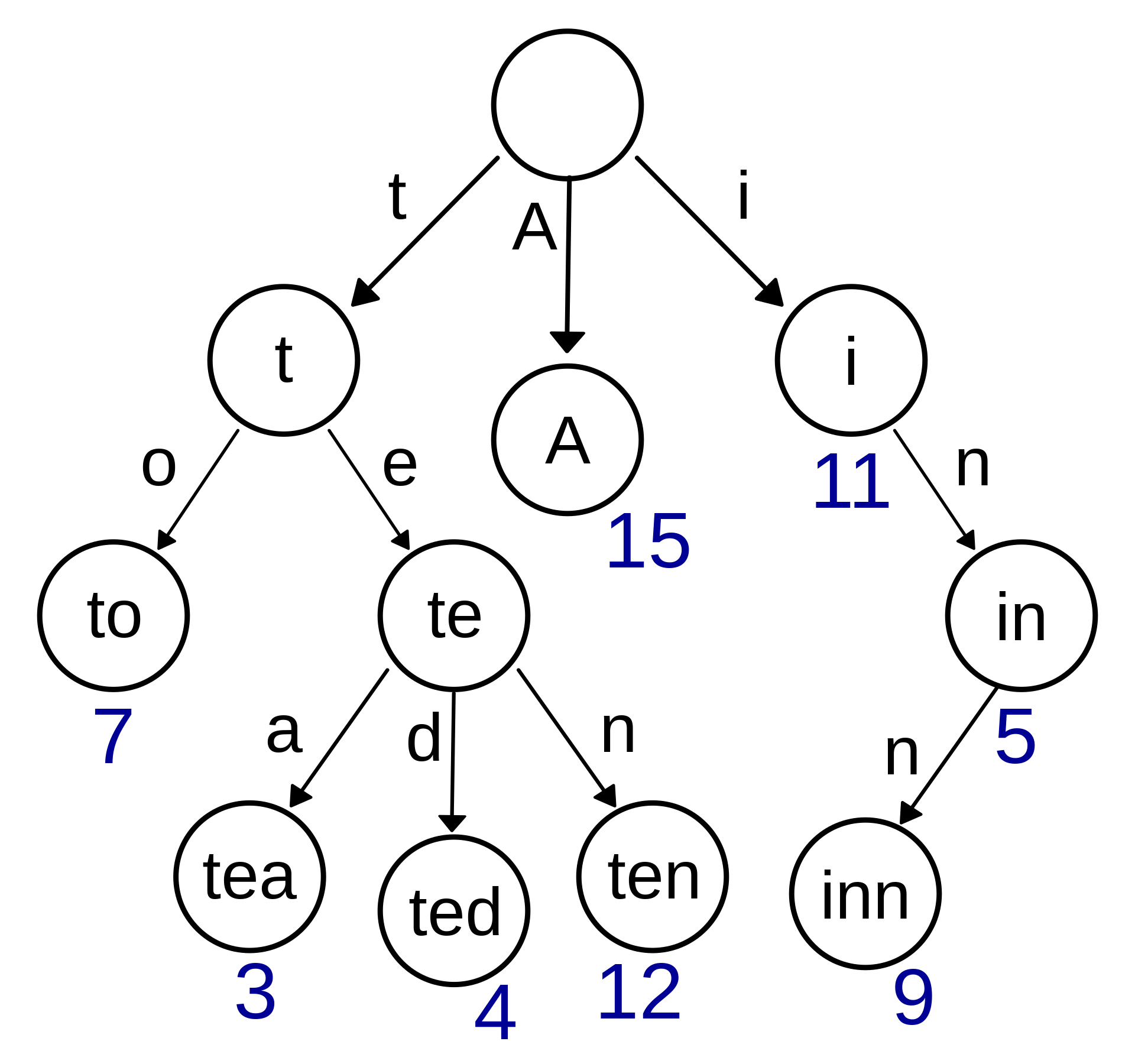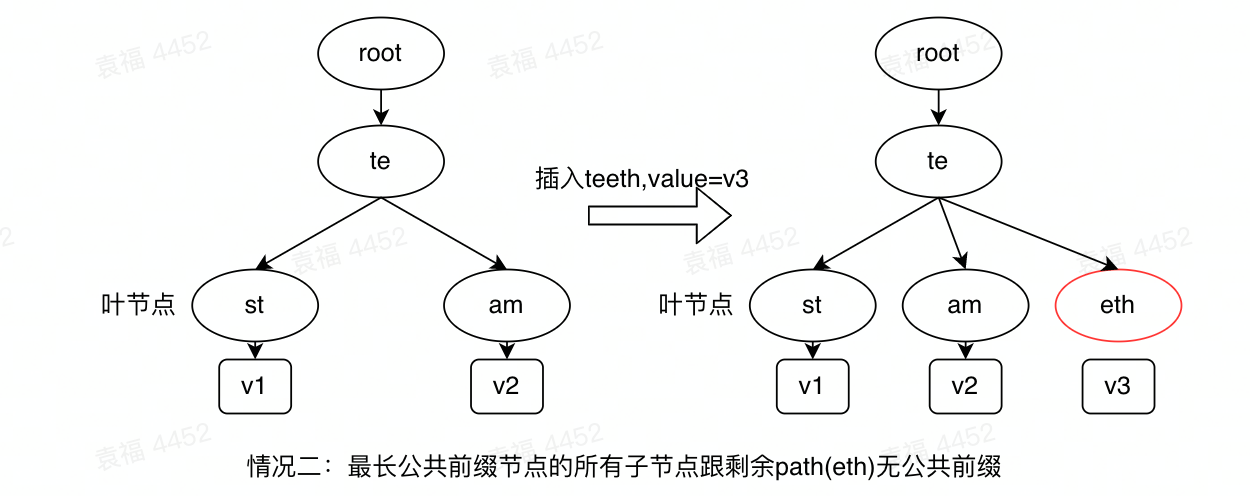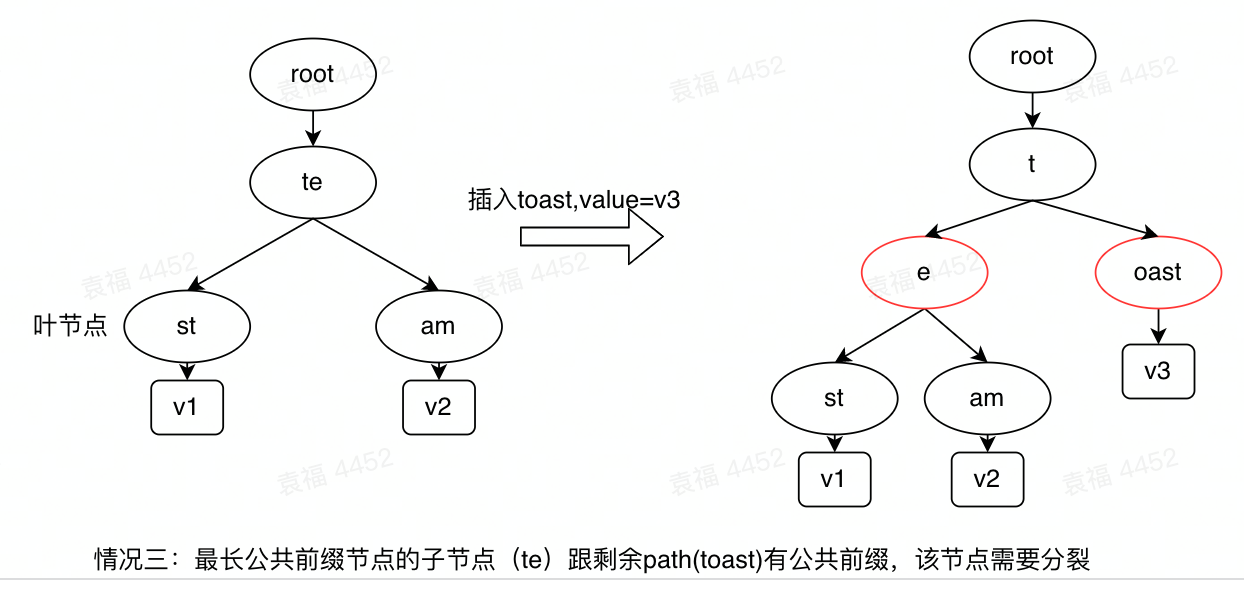gin框架(1)- 路由原理:trie和radix tree
1. 前言
本篇是对gin框架源码解析的第一篇,主要讲述gin的路由httprouter的原理:radix tree(压缩字典树)。
2. Trie(字典树)
在讲述radix tree之前,不得不简单提到radix tree的基础版本trie,又叫字典树,前缀匹配树(prefix tree),适合存储key为string,且所有key含有大量公共前缀的map型数据结构,示例如下:

图1 trie示例(from wiki)
trie的讲述和应用,已经有很多珠玉在前,在此推荐Leetcode 208 实现Tire 和 前缀树算法模板秒杀 5 道算法题 , 完成这两部分,基本就能对trie及其相关问题得心应手。在此主要介绍一些常见的trie的应用场景:
- 字符串排序:构造一颗trie,并且其每个节点的所有子节点的key顺序是按字典序进行排列的,那么按照前序遍历去访问这颗trie,就是有序的字符串。这样排序的时间复杂度和空间复杂度都比较低。
- 字符串匹配:KMP作为最著名的字符串匹配算法,用来判断一个长文本中是否包含某个特定的短文本字符串,其时间复杂度大致等于O(n),n为长文本的字符数量。假设现在有一堆短文本字符串(m个短文本字符串),需要找出所有在长文本中存在的短文本字符串(长文本的字符数量为n),应该如何实现?一个简单的思路是对每个短文本字符串调用KMP算法,那么时间复杂度即为O(n*m)。但是如果采用trie来实现匹配,其时间复杂度应该介于O(n)和O(n*m)之间(具体取决于所有短文本字符串的公共前缀的数量)。
- 索引存储:本质上还是利用trie前缀匹配的特性,在相应的子节点存储上对应数据的存储位置,当用户输入查询条件时,可以快速查找符合用户输入前缀的相应数据,常用于搜索引擎。
3. radix tree(压缩字典树)
压缩字典树是字典树的优化版本,字典树每个节点上只存储一个字符;而压缩字典树每个节点上存储着一个或多个字符;父节点上存储的字符为所有子节点的公共前缀。示例如下:

图2 radix tree示例(from wiki)
对于有大量公共前缀的多个字符串,采用radix tree可以显著减少节点数量,加快匹配速度。而URL路由就存在大量的公共前缀,因此很适合用radix tree来存储路由信息。
3.1 radix tree结构定义
class Node: def __init__(self, path, has_value=False, value='', children=None): self.path = path # 该节点存储的路径,也可以增加一个数据,存储从根到该节点的完整路径 self.has_value = has_value # 是否有存储数据 self.value = value # 叶节点的数据 if children == None: # 注意此处的默认值初始化方式 self.children = [] else: self.children = children # 该节点的所有子节点,子节点也为Node类型
然后一颗radix tree级又用以上节点组成的一颗树。
class RadixTree: def __init__(self): self.root = Node(path = '') # 声明一个根节点,根节点不包含任何数据
3.2 查找操作
查找时,从根节点出发,伪代码如下:
class RadixTree: def lookup(path): node = self.root # 从根节点开始 1. for循环遍历node的每一个子节点child,查看child.path和path: if child.path == path and child.has_value: return True # 找到节点 elif len(child.path) < path and child.path == path[:len(child.path)]: # 匹配上前缀,继续查询该节点的子节点 node = child,path = path[len(child.path):],并回到步骤1 else: # 没匹配上,继续下一个节点 continue 2. for循环结束,还没有找到匹配的节点,返回False
为了后续的删除操作(删除操作需要找到path对应的节点,不论该节点是叶子节点还是路径节点),对查找操作稍微修改一下,对应的python代码如下:
class RadixTree: def find_node(self, path): """返回值为has_node(True or False), node(None if not exist) 注:即使返回了node,也不代表该node有value值,可能该node只是一个路径节点 """ if path == '': return True, self.root node = self.root index = 0 while index < len(node.children): child = node.children[index] if child.path == path: return True, child elif len(child.path) < len(path) and child.path == path[:len(child.path)]: node = child path = path[len(child.path):] # 截断公共前缀的部分 index = 0 continue else: index += 1 return False, None
3.3 插入操作
插入节点时,节点的全路径为path,首先找到radix tree上跟该path有最长公共前缀的节点longes_prex_node,查看longes_prex_node的全路径longes_prex_node.path和path的关系,如果longes_prex_node.path=path,说明存在该节点,直接在该节点插入值即可;如果longes_prex_node有某个子节点child的path与new_path=path[len(longes_prex_node.path):]有公共前缀,则以公共前缀单独分裂成一个节点替换掉该child,并将剩下的路径生成一个新的节点作为该child的子节点;如果longes_prex_node没有子节点的path与new_path=path[len(longes_prex_node.path):]有公共前缀,则直接将剩下的路径作为一个子节点,添加到longes_prex_node的末尾即可。常见的三种插入情况如下:



图3 插入操作的常见情况
可见插入需要找到最长公共前缀节点(需要该辅助方法),然后执行插入操作,具体的代码如下:
class RadixTree: def find_longest_prex_node(self, path): """返回值为node(最长公共前缀节点), prex(最长公共前缀) """ if path == '': raise Exception('path cannot be empty') node = self.root index = 0 common_prex = '' # 记录公共前缀 while index < len(node.children): child = node.children[index] if child.path == path: common_prex = path return child, common_prex elif len(child.path) < len(path) and child.path == path[:len(child.path)]: common_prex += child.path node = child index = 0 continue else: index += 1 return node, common_prex def insert(self, path, value): common_prex_node, common_prex = self.find_longest_prex_node(path) if common_prex == path: # 已经存在该节点,直接更新值 common_prex_node.has_value = True common_prex_node.value = value path = path[len(common_prex):] # 剩余path for idx, child in enumerate(common_prex_node.children): if child.path[0] == path[0]: # 有公共前缀,把公共前缀作为一个单独的子节点 i = 0 while i < len(child.path) and i < len(path) and child.path[i] == path[i]: i += 1 new_child = Node(child.path[:i]) # 新的child grandson = Node(child.path[i:], has_value=child.has_value, value=child.value, children=child.children) #继承现有child的所有成员 new_child.children.append(grandson) new_child.children.append(Node(path[i:], has_value=True, value=value)) # 要插入的值的位置 common_prex_node.children[idx] = new_child return # 遍历完还没有返回结果,说明没有跟common_prex_node的所有child没有公共前缀 node = Node(path, has_value=True, value=value) common_prex_node.children.append(node) return
3.4 删除操作
删除操作首先是找到待删除的节点node,然后分三种情况:
- 如果该节点没有children,则直接移除该节点;此时如果该节点父节点只剩下一个孩子,需要将父节点和父节点剩下的一个孩子合并;
- 如果该节点只有一个children,则node.path = node.path+node.children[0].path(跟其孩子节点的path merge), 然后node.value = node.children[0].value
- 如果该节点有多个children,则直接将其变成路径节点即可(node.has_value=False, node.value=null)
所以要删除,首先要找到对应的节点,因此查找函数除了返回True or False之外;如果返回True,还需要返回该节点,方便删除操作使用。
对应的python代码如下:
class RadixTree: def delete(self, path): has_node, node = self.find_node(path) if not has_node or node.has_value == False: return if len(node.children) == 0: # 直接删除该节点,需要找到其父节点 _, parent_node = self.find_node(path[:len(path)-len(node.path)]) idx = 0 while idx < len(parent_node.children): if parent_node.children[idx].path == node.path: break idx += 1 if len(parent_node.children) == 2: # 说明移除该节点之后只剩下一个节点了 parent_node.path += parent_node.children[1-idx].path parent_node.has_value = parent_node.children[1-idx].has_value parent_node.value = parent_node.children[1-idx].value parent_node.children = parent_node.children[1-idx].children return else: parent_node.children = parent_node.children[:idx] + parent_node.children[idx+1:] return elif len(node.children) == 1: node.path = node.path + node.children[0].path node.has_value = node.children[0].has_value node.value = node.children[0].value node.children = node.children[0].children return else: node.has_value = False node.value = ''
3.5 遍历操作
为了检查以上插入,删除,查找的正确性,写了一个遍历RadixTree的辅助函数:
class RadixTree: def traverse(self): full_path = '' self.DFS(self.root, full_path) def DFS(self, node, full_path): if node == None or len(node.children) == 0: return for i in range(len(node.children)): child = node.children[i] full_path += child.path print('node full path: {}, node path: {}, has_value: {}, value: {}'.format(full_path, child.path, child.has_value, child.value)) self.DFS(child, full_path) full_path = full_path[:len(full_path)-len(child.path)]
4. httprouter概述
gin的路由注册采用的是httprouter。httprouter是基于radix tree实现的前缀匹配。httprouter在实现radix tree时增加了一些针对url的优化:
(1)每一种http方法一个 radix tree,这样可以提高匹配效率;
(2)提供了通配符 ":" 和 "*",其中 ":"+参数名称 表示路径参数,比如 GET /template/:user_id,其中 ":user_id" 就是一个路径参数,访问时用户输入url: /template/12345,则user_id=12345。"*"+参数名称 为匹配所有参数,结构只能为 .../.../.../*param_name,"*" 只能作为结尾参数。

